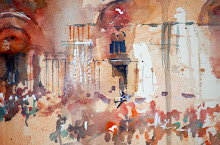"Sweet Love"
Possibly the last rose, painted from my garden this summer
I have been thinking about one of the questions asked following my talk at the Wey Gallery during the opening of my one woman show " Colour Fusion" last weekend. It is one I have been asked many times.
"How many of your paintings don't work out ?"
It is a great question isn't it. And in truth I suppose I could answer that not many end up in the bin these days. But how long did it take for me to get to this stage in my art journey. And I shouldn't forget all those experimental washes that I start each day with, not meaning for them to turn into paintings but they often do.
I think the easiest way to help answer this question is for me to take the above painting as a visual example of where I am heading with this blog post. This rose, one of the last from my garden this Summer started out as a first wash of soft pinks and greens. There was no definition initially and I was working from looking at the real flower. This had been cut as a single stem and placed in a vase with lovely green foligae behind it. Then placed near my desk easel to study.
Artist Tip: Study your subject well, observe its' colour and shape before you even think about picking up a brush.
I chose Opera Rose and Perylene Green as my main colours. Working on dry paper I applied a block section of pink colour at first, in the suggestive shape observed from the real flower. This was almost completely circular. I allowed watermarks to run at will in places throughout the wash ,whilst deliberately encouraging other water marks to form hints of the many petals in this particular rose variety. I then placed one strong leaf at the top of the flower to strengthen my outline edge of the rose.
First wash with watermarks and missing detail.
A loose "mess"!
Creating a good starting point from a first wash, as a basis for a successful loose painting is fascinating. I think it is at this stage that many new artists " give up". Because they can't see how the next brush strokes can bring the subject to life. It is having the imagination and courage to work further that makes or breaks a painting. But this is also the stage where as an artist I have nothing to lose. If it goes wrong the painting is an experiment I can learn from. But if it goes right, I have that magical sensation of achieving a good result.
At this stage I have to consider two points. Adding too much detail next could ruin my loose painting as it could move into the slightly botanical realm and well away from the atmospheric result I was aiming for. But by not adding enough definition, the piece could end up looking a mess that isn't worthy of even being called an abstract. I try to marry a loose background with enough detail to tell the story of what my subject is. But without my finished result being overly fussy or over worked.
Working loose in watercolour this way is exciting as pigment reaction with water is always unique in how it dries. I enjoy my first washes of any given subject, often waiting patiently allowing each stage to dry before working further, adding the detail. Only when my first wash is completly dry can I consider what the painting truly needs.
And so a few darks, a few fine lines, a few additions of petal detail turns a "blurry" loose mess into a stunningly beautiful rose in watercolour.
"Sweet Rose"
Petals unfurling and wrapping around an inner centre that carries such sweet perfume.
Artists Tip: Never give up on a painting unless you aren't enjoying the creative process. Take time to study your subject and your initial washes, think about how each new brushstroke can add or detract from what you are trying to achieve and practise until you gain results that are pleasing you. And remember, at the end of the day, painting should be enjoyable, not a chore!
***************
Its' wonderful seeing how popular my blog post on " How to paint roses in a loose style" still is. So I am hoping this blog post with more detail will help followers with their own paintings of roses. They are such wonderful flowers to paint!



































